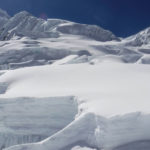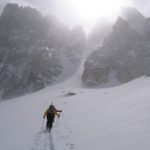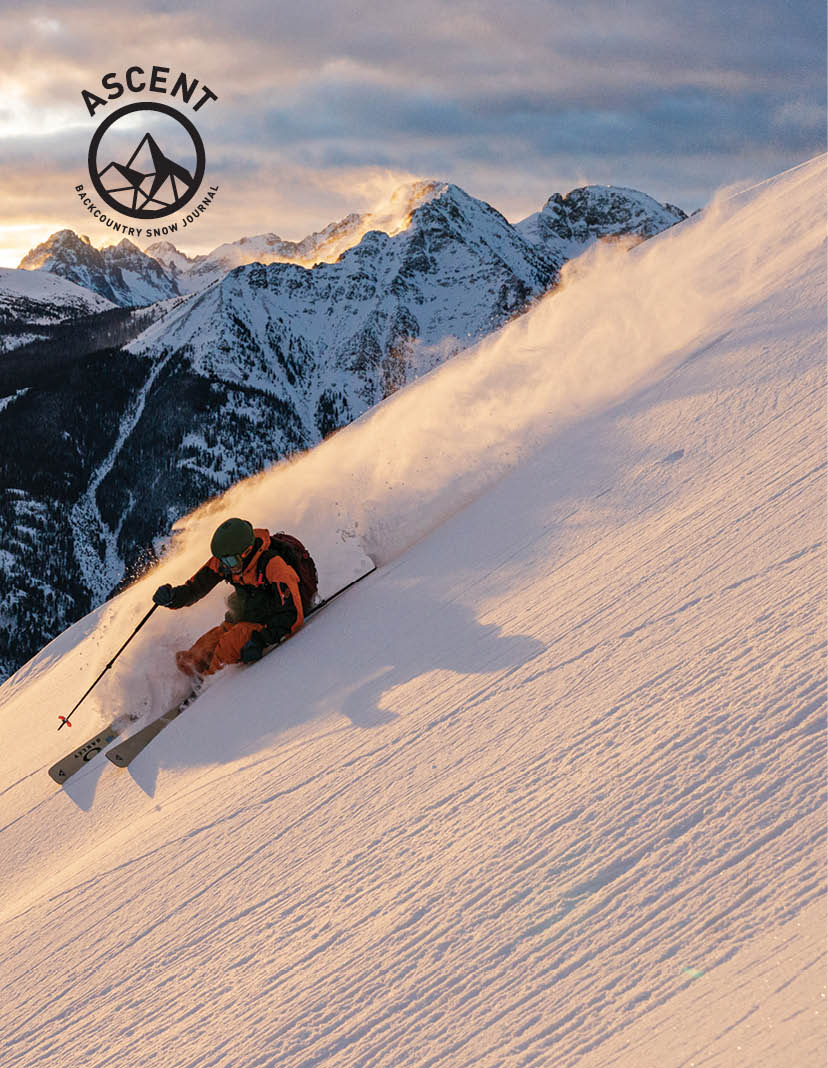In April 2019 two houses a couple of miles west of Ketchum, Idaho on the Board Ranch were completely destroyed by an avalanche. Both houses had been built more than 50 years earlier, were pushed off their foundations by the 40 feet of avalanche debris filled with trees from the slide path and, fortunately, were unoccupied at the time. There were no injuries. Long-time residents of the Board Ranch said they had never seen avalanches of such magnitude.
U.S. Highway 550 between Silverton and Ouray, Colorado, is often called the “Million Dollar Highway” and “The most dangerous road in America” because it was constructed in precarious terrain, the avalanches that consistently covers it and the high cost of building and maintaining the road and clearing it of avalanches. On March 3, 2019 Phil Maeir, a driver for the Colorado Department of Transportation, was clearing a winding section of 550 outside Ouray when, according to the Colorado Springs Gazette, “…around every bend, was a new avalanche bigger than the last. Near the turnoff to Engineer Pass at County Road 18, a stretch of asphalt he had never seen touched by a slide was inundated with snow…..’I got it open in a couple tries, but then I went around another turn and another big one (avalanche) run right up on top of the truck and stuck it,’ Maeir said. ‘I couldn’t go nowhere.…Under the dark night sky, everything went white.’ Snow as heavy as cement caked the windshield, the side windows, even over the hood. He wanted to hop out to orient himself, but he feared he might step off the edge of the Million Dollar Highway and into the Uncompahgre River roaring hundreds of feet below. He pleaded over the radio for a patrolman to rescue him and for the region’s avalanche forecaster to stay with him as he watched himself get buried. ‘Ann (the forecaster) was yelling back, ‘Hang on! Hang on! We’re coming for you. We’ll find you.’ I reversed back and forth, back and forth, and finally punched through.” He stepped on the gas and gunned it back to the safety of CDOT’s shop near the Ouray Ice Park. For the next two hours, until nearly 1 a.m., his hands could not stop trembling. “That night was what I imagine hell is like,” he said.
Adam Voiland reported on NASA’s Earth Observatory blog: “In July 2016, the lower portion of a valley glacier in the Aru Range of Tibet detached and barreled into a nearby valley, killing nine people and hundreds of animals. The huge avalanche, one of the largest scientists had ever seen, sent a tongue of debris spreading across 9 square kilometers (3 square miles). With debris reaching speeds of 140 kilometers (90 miles) per hour, the avalanche was remarkably fast for its size.
“Researchers were initially baffled about how it had happened. The glacier was on a nearly flat slope that was too shallow to cause avalanches, especially fast-moving ones. What’s more, the collapse happened at an elevation where permafrost was widespread; it should have securely anchored the glacier to the surface.
“Two months later, it happened again — this time to a glacier just a few kilometers away. One gigantic avalanche was unusual; two in a row was unprecedented. The second collapse raised even more questions. Had an earthquake played a role in triggering them? Did climate change play a role? Should we expect more of these mega-avalanches?”
In February 2019 what was called by Chris Carr “A hundred year avalanche” came down California’s Mt. Shasta, which has throughout recorded history hosted more snow and avalanches than most mountains in the west. Carr, co-owner with his wife Jenn of Shasta Mountain Guides, has guided on Shasta for more than 25 years and said he had never seen anything like it. He told Redding’s Record Searchlight newspaper, “The most unique thing was how low that wall of snow was, much further down than anything I had ever experienced,” Carr said. “It was so startling how low it was and how big it was.”
The slide started at about 12,000 foot elevation on the west side of the mountain and dropped 5,000 feet over four miles, carving a 300 foot wide swath of destruction, ripping out hundreds of trees and leaving 40 foot walls of snow and trees on both sides of its path. Fortunately, the Everett Memorial Highway that goes from the town of Mt. Shasta to the trailhead on the west side was closed and no people were in the path of the hundred year avalanche.
On April 18, 2014 an avalanche in the Khumbu Icefall on the Nepal side of Mt. Everest killed 16 Sherpa climbing guides and porters in the deadliest disaster in that mountain’s deadly history. According to Scientific American Magazine, “Rising global temperatures have shrunk the total area of Nepal’s glaciers by almost a quarter between 1977 and 2010, with an average of 38 sq. km (14.67 sq. miles) vanishing every year, the International Centre for Integrated Mountain Development (ICIMOD), based in the Nepali capital, says in a report.
“Besides bringing harsher and more frequent floods, avalanches and landslides affecting millions of people living in remote mountain villages, such changes could also hit adventure-seeking trekkers, the report’s lead author says.
“’The frequency of avalanches like the one that struck at the Everest base camp last month may increase due to global warming,’ Samjwal Bajracharya, lead author of the report, told the Thomson Reuters Foundation.”
In February 2019 Reuters reported: “Icy Arctic islands north of Norway are warming faster than almost anywhere on Earth and more avalanches, rain and mud may cause “devastating” changes by 2100, a Norwegian report said on Monday.
“The thaw on the remote Svalbard islands, home to 2,300 people and where the main village of Longyearbyen is 1,300 kms (800 miles) from the North Pole, highlights risks in other parts of the Arctic from Alaska to Siberia.
“Average temperatures on Svalbard have leapt between three and five degrees Celsius (5.4-9.0 Fahrenheit) since the early 1970s and could rise by a total of 10C (18F) by 2100 if world greenhouse gas emissions keep climbing, the study said.
“Almost 200 governments promised in the 2015 Paris climate agreement to limit a rise in average global temperatures to “well below” 2C (3.6F) above pre-industrial times by 2100. Worldwide, temperatures are up about 1C (1.8F).
“On Svalbard, the envisaged rise in temperatures would thaw the frozen ground underpinning many buildings, roads and airports, cause more avalanches, “slushflows” and landslides, melt glaciers and threaten wildlife such as polar bears and seals that rely on sea ice to hunt.
“A 10 degree warming, with the implications for Arctic nature, ice-dependent species, will be devastating,” Climate and Environment Minister Ola Elvestuen told Reuters.”
It goes on and on and on as average global temperatures go up and up and up and avalanches come down and down and down. The few examples described above are indicative of what is happening everywhere on Earth where snow accumulates. It is safe to posit that it is only going to get worse and less predictable.
In the big picture of the consequences of human caused global warming to planet earth and everything that lives upon it, the increase in size and number of avalanches are a small portent of a larger catastrophe we have brought upon ourselves and our home. But for those of us who reside near or visit avalanche terrain and for whom snow is integral to the way we live, the growing avalanches of global warming are as threatening as rising seas are to those living close to their shores. Acknowledging the reality of human caused global climate change and learning as much as possible about its causes and possible consequences is a sane first step to dealing with them, and acknowledging and learning about the causes and consequences of modern avalanches is a sane first step to life in today’s mountains. Alas, that necessary first step is more difficult to make in America than any other country on Earth. Everyone reading this is aware that U.S. President Donald Trump and his minions in government and business are deniers of human caused global warming, though it is an open question whether Trump and his government lackeys are actually the minions of the Koch Brothers and others business entities with better known names. Either way, the majority of the most knowledgeable people about avalanches in America work in some capacity for the U.S. government, and they have been told by those higher up the chain of command that they are not to talk to the press about climate change, including its effects on avalanches.
So…..In the current heated climate of American government thought police, attempting to find sane answers to the reality of current avalanches (or, it can be assumed, the reality of anything) from U.S. government sources is going to be difficult, discouraging, even futile.
As Bob Dylan, one of America’s greatest poets put it more than 50 years ago:
Johnny’s in the basement mixin’ up the medicine
I’m on the pavement thinkin’ about the government
And
Keep a clean nose, watch the plainclothes
You don’t need a weatherman to know which way the wind blows
And you don’t need an avalanche expert to know which way the avalanche flows. If you spend time in the mountains it’s flowing towards you. Ask Phil Maeir or the families of the 16 Sherpas killed on Everest in 2014 how that feels. Don’t ask the thought police or the human caused climate change deniers who employ them. They cannot be trusted with your thoughts, feelings or access to honest information that will help you make decisions about how to live sanely and safely on Earth, in avalanche terrain and elsewhere. In my opinion, you cannot trust them with anything.
Fortunately, you do not need to trust them with your thoughts and feelings, and honest information about the growing avalanches of global warming is readily available to the inquisitive researcher. Every avalanche center in America is filled with reliable daily information about the current local snow, weather and avalanche conditions and the history of all the days of the center’s existence. Sometimes it’s easier to find information outside the local avalanche centers, information to give you a larger understanding of the bigger picture. Just last season Colorado had 750 % of the average snow on the ground in June compared to the historical average. The Sierra Nevada received 188% of average snow last year. Both of these examples of heavy snowfall are anomalies, as the overall yearly snowfalls have consistently declined in America over the past 50 years. In the Sierra Nevada the average amount of precipitation has decreased on average about 1.2% each year, and more of that is falling as rain than in earlier times. That is, extreme weather swings is the new normal. That’s how Colorado can have 750% of average yearly snowfall, yet snowfall is declining throughout the U.S. Most but not all of the people who have the most knowledge about America’s avalanche conditions and potential and history work for those avalanche centers. While they are not officially allowed to speak to the press about global warming’s effect on avalanches, it is their job to keep the public informed about current avalanche conditions in the areas of their responsibility and to keep records of those conditions. Those records, unlike the speech of those who keep them, are open to the public. Since the government which in theory should work on behalf of its citizens is incapacitated by the current administration, it is the public’s responsibility to have the courage to defy, protest against, undermine and, one might hope without much hope and against all indications, educatethat administration and its thought police about the reality of human caused global climate change, its causes and what we know so far of its consequences. A (very) few of the avalanche consequences are mentioned at the beginning of this article which is one of my own personal contributions to defying and, one can still hope, educating the Trumpers about the heartless stupidity and cowardliness of denial. What are your contributions, esteemed reader? Don’t be like one of the eleven poltroon Republican members of the Oregon State Senate who ran away last summer from their jobs as elected public servants and hid in neighboring states in order to avoid voting on a climate bill. Do your jobs, fellow citizens of mountain living, protest stupidity, educate the ignorant; help keep everyone, including pathetic deniers, out of the paths of the growing avalanches of global warming.


















And yet, from an article on this very website published the same day : “Last January I found myself in Kyrgyzstan’s capital, Bishkek. I had come on assignment to work with 40 Tribes, a boutique guiding outfit that specializes in taking skiers and riders to some of the most far off places in the world to experience wild snow…… It was solid trip across many time zones to get to this far off location, but as we loaded Kas’s car and set off for the multi hour drive from the capital of the country to the small, snowy town of… Read more »